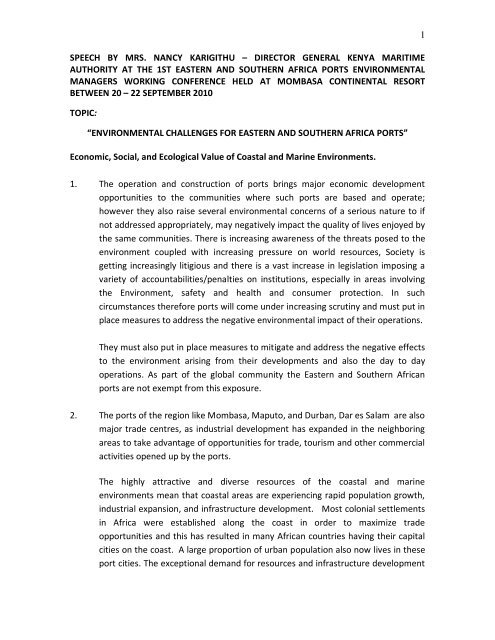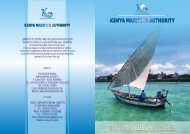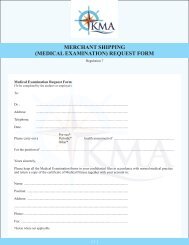1 speech by mrs. nancy karigithu â director general ... - PMAESA
1 speech by mrs. nancy karigithu â director general ... - PMAESA
1 speech by mrs. nancy karigithu â director general ... - PMAESA
You also want an ePaper? Increase the reach of your titles
YUMPU automatically turns print PDFs into web optimized ePapers that Google loves.
SPEECH BY MRS. NANCY KARIGITHU – DIRECTOR GENERAL KENYA MARITIMEAUTHORITY AT THE 1ST EASTERN AND SOUTHERN AFRICA PORTS ENVIRONMENTALMANAGERS WORKING CONFERENCE HELD AT MOMBASA CONTINENTAL RESORTBETWEEN 20 – 22 SEPTEMBER 2010TOPIC:“ENVIRONMENTAL CHALLENGES FOR EASTERN AND SOUTHERN AFRICA PORTS”Economic, Social, and Ecological Value of Coastal and Marine Environments.11. The operation and construction of ports brings major economic developmentopportunities to the communities where such ports are based and operate;however they also raise several environmental concerns of a serious nature to ifnot addressed appropriately, may negatively impact the quality of lives enjoyed <strong>by</strong>the same communities. There is increasing awareness of the threats posed to theenvironment coupled with increasing pressure on world resources, Society isgetting increasingly litigious and there is a vast increase in legislation imposing avariety of accountabilities/penalties on institutions, especially in areas involvingthe Environment, safety and health and consumer protection. In suchcircumstances therefore ports will come under increasing scrutiny and must put inplace measures to address the negative environmental impact of their operations.They must also put in place measures to mitigate and address the negative effectsto the environment arising from their developments and also the day to dayoperations. As part of the global community the Eastern and Southern Africanports are not exempt from this exposure.2. The ports of the region like Mombasa, Maputo, and Durban, Dar es Salam are alsomajor trade centres, as industrial development has expanded in the neighboringareas to take advantage of opportunities for trade, tourism and other commercialactivities opened up <strong>by</strong> the ports.The highly attractive and diverse resources of the coastal and marineenvironments mean that coastal areas are experiencing rapid population growth,industrial expansion, and infrastructure development. Most colonial settlementsin Africa were established along the coast in order to maximize tradeopportunities and this has resulted in many African countries having their capitalcities on the coast. A large proportion of urban population also now lives in theseport cities. The exceptional demand for resources and infrastructure development
in the coastal zone is putting pressure on fragile ecosystems and coastalecosystems are under severe threat from development related activities.2The major challenges facing coastal countries in the region at present are coastalerosion, the potential impacts of climate change, over harvesting of resources andpollution.3. While Ports are part of the logistics chain and the transport networks with adecisive role in the protection of the marine environment, port expansion ordevelopment always raises a balancing problem of priority betweenenvironmental and social-economic issues. The strategic location of the portsbetween sea and land makes them the best witnesses of pollution coming fromland, ships and from the ports themselves.The port environment is threatened <strong>by</strong>: port's hinterland, ships activity, portactivity and port operation. Ports pollution may result from ship accidents,accidents in ports, land activities, ship bunkering, noises, garbage, dust, dredging,port maintenance, ship air pollution, traffic congestion, sewage and others.4. The environmental concerns facing ports in this region are common to all theports, and these range from diverse issues like the challenges posed <strong>by</strong> shipsoperational waste, sewage and garbage, oil spills from marine accidents, dredgingand disposal of dredged material, air pollution, traffic congestion, effluentdischarge, hazardous cargo, dust, water quality, noise, loss of or degradation ofhabitat for local communities due to lack of adequate urban planning, poor waterquality (arising from contamination with bilge water, ballast water, oily wastes,sewage, garbage and other residues in a ship, spills of oils, lubricants, fuels andother oily liquids). Repair docks are possible sources of toxic or harmful materialssuch as anti-foulants, paints, or heavy metals among others, handling ofdangerous cargo.Other challenges include:-• Bunker operations in port areas constitute, indeed, a great danger for oilpollution. Handling of cargo generates dust, especially dust coming fromphosphates.• Commodities may fall from cranes or are damaged <strong>by</strong> forks and forklift trucks.Damages are caused also <strong>by</strong> chemical products imported through the ports.
• Furthermore, pollution is generated from the maintenance of port infrastructureand superstructure works, pollution may also come from maintenance of port'sequipment and superstructure due to grit blasting and spray painting or from shiprepairs in the port area.• Congestion at ports leads to increased energy consumption, operational pollutionand loss of time and comfort.3• Oil pollution is a major threat, with high levels of oil transportation threateningthe Eastern and Southern African coast and the Islands, and oil drilling andprocessing activities may in the near future cause problems along the Eastern andSouthern African coasts.• Other environmental challenges include the visual quality of a project area whichis affected <strong>by</strong> the creation of a port, port facilities, lighting, and other opticaldisturbances, thus changing the landscape into an artificial scene ofindustrialization.• Alien invasive plants cause changes to freshwater availability and alter thediversity and abundance of species within ecosystems. Aquatic weeds also changewater quality <strong>by</strong> adding or removing nutrients and thus affect drinking waterquality and human health.4. The subject of marine pollution has received much attention from such esteemedorganisations like the International Maritime Organisation (IMO), United NationsConference on Trade and Development (UNCTAD, 1993), United Nations, ComitéMaritime International (CMI), International Navigation Association (PIANC), WorldBank and others. Out of the work of these organisations a lot ofrecommendations have arisen of which ports in East and Southern Africa need totake cognisance.The attention of the international community has however, been concentratedmainly to port's visitors, (i.e. the ships themselves), because of the well-known riskfrom marine accidents.6. The following international instruments are relevant:o The London Dumping Convention 1975, addressing the issue of materialdredging from ports and how to deal with them;
4o The International Convention for the Prevention of Pollution from ships(MARPOL 73/78), dealt with pollution of the sea from oil and therequirement for the provision of facilities for waste reception in ports; theconvention calls for the provision of port reception facilities as but theseare available in a very few of the region’s ports and even then they areinadequate, making the risk of illegal discharge of ship generated wastevery real;o Convention of Oil Pollution Preparedness, Response and Cooperation1990, addressed the issue of contingency planning in oil pollution cases inemergency situations in ports;7. The East and Southern African countries have responded to the challenges ofenvironmental change <strong>by</strong> ratifying international agreements, participating inregional and sub-regional initiatives and programmes, and <strong>by</strong> developing NationalEnvironmental Action Plans (NEAPs), Integrated Resource Management Plans(IRMP), Environmental Impact Assessment (EIA) regulations, and other relevantlegislation. Such responses are important as they set the framework at the highestlevel for integration of environmental issues into national governance andestablish the boundaries of and administrative capacity for action at national andsub-national levels. African countries have some of the most advanced andcoherent policies for environmental management in the world and someexemplary models of public participation in policy formation and decision-making.However, Africa's nations must not be allowed to rest on their laurels.The region states have also ratified conventions on the prevention of pollution ofthe marine environment <strong>by</strong> oil, chemicals, garbage, sewage, ballast water, anddumping of wastes and other matter.Solutions:-• Port State Control should be enforced and become more effective.The amelioration of the ports' reception facilities will help in thedirection of a more efficient transport sector and also address notjust oily residues but also the reception of sewage and garbagewhich is required in accordance with the needs of calling ships;• Connection to sanitary treatment facilities or a municipal wastetreatment system may be a means for a port to receive suchwastes;
• Provision of these facilities and the promulgation of regulations ondischarge of oily residues, and proper detection are keys tosuccessful control of ship discharges.• Unsanitary discharges from repair docks should also be connectedto appropriate waste treatment systems• Regulation and proper detection of emissions from ships to reducedischarges of pollutants• Cargo handling equipment and road traffic, two major sources ofnoise and vibration, which may cause unacceptable levels of stressamong local people. Appropriate selection of the location of portcan mitigate these adverse effects.5The ports must also embrace collaborative mechanisms to deal with thesecommon problems. With Forums like the AU, <strong>PMAESA</strong>, EAC and SADC it is hightime that we take advantage of the opportunities that are presented in order toexplore common grounds and solutions.8. The World Bank through the Global Environmental Facility Trust Fund hasdeveloped a Western Indian Ocean Region Electronic Marine Highway Projectwhose objective is to increase the safety and efficiency of navigation and toreduce the risk of ship-based environmental contamination (such as oil spills fromgroundings and illegal discharges of ballast and bilge waters). This will be achieved<strong>by</strong> establishing a demonstration marine highway to guide ships aroundenvironmentally sensitive areas and through selected busy sea-lanes. The projecthas four components:• the installation of modern aids to navigation systems (marine highway),• capacity building for prevention of coastal and marine contamination,• building of a regional oil and chemical spill response capability, and• widening of the regional agreement on port state control and implementationof its provisions, support for monitoring of fisheries activities, and activities topromote coordination and collaboration with other relevant projects.9. Priorities For Future ActionPriorities for action include strengthening of existing mechanisms <strong>by</strong> investment inequipment and personnel, as well as enhancement of coordination between
government departments and other related organizations, so that environmentaland development issues are integrated into all decision making at the national andsub-regional level. Some broad outlines for progress include:• Using climate change fora to exert pressure on the international community toimplement the proposed mechanisms for emissions trading, reforestationschemes, and cleaner development, measures from which everyone stands togain economically and environmentally.• Strengthening of hazard monitoring programmes, early warning, and responsesystems to effectively mitigate and cope with the impacts of extreme events,increase food security, and maintain healthy ecosystems.• Radical reforms to the energy and transport sectors, including: developmentand adoption of appropriate clean technologies (to alleviate dependence onwood and fossil fuels without increasing emissions of GHGs, promotion ofunleaded fuels and conversion to cleaner fuels, and upgrading of publictransport systems.• EIAs should be conducted as part of proactive and holistic developmentplanning. These should be integrated into an overall development plan for aregion or area, so that cumulative impacts of all developments are consideredand habitat loss and fragmentation are minimized. Highest priority should begiven to improved urban planning, provision and maintenance of basicinfrastructure and services, and to innovations in design to meet the demandfor port development and for housing sustainably.10. The decision of ports to become "cleaner and cleaner" seems to be anindisputable reality. The challenge today is to obtain a collective commitmentbased on certain uniformity in measures applied and in the calculation of the CO 2footprint. The big international port organizations, International Association ofPorts & Harbours (IAPH), American Association of Port Authorities (AAPA), andEuropean Seaports Organization (ESPO), have expressed their willingness to backup the regions port authorities in this struggle against global warming. TheInternational Association of Cities and Ports (IACP) is likewise committed and willactively mobilize its network of cities and ports to encourage them to co-operateclosely on the subject with a view to supporting the proposed actions.6To quote the IMO Secretary General “humanity is on the horns of a dilemma. For,whether we like it or not, our collective way of life has become unsustainable andwe need to do something about it. and soon. The choices we have made about the
way we lead our lives have been slowly eating away at the very support systemthat enables us to live and breathe. This cannot, and should not, go on. We needto make some tough decisions, we need to make them now, and we need to acton them as one, with total and undivided commitment, today and in the future.Faced with facts we cannot argue against, we need to consider our priorities andaccept that we have to make certain sacrifices; we need to start putting life aheadof lifestyle. To introduce a maritime analogy, climate change is like a giant oiltanker, in that, to stop it, or even to alter its course, not only takes a massive forcebut also a considerable amount of time and distance, even though it only takes alight push on the right button on the engine panel or the autopilot to actuallyinitiate the action of stopping or changing course.”7Thank youDIRECTOR GENERALKENYA MARITIME AUTHORITY





